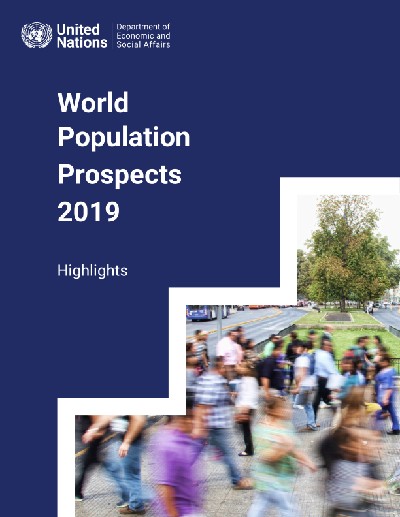"世界人口总数"相关数据
更新时间:2022-08-242019年世界人口展望
Understanding global population trends and anticipating the demographic changes to come are crucial to the achievement of the 2030Agenda for Sustainable Development. The 2030Agenda emphasizes that people are at the centre of sustainable development,echoing the ideals set forth in the Programme of Action of the International Conference on Population and Development adopted in Cairo in 1994.Population trends observed over the past few decades point to substantial progress made towards several of the Sustainable Development Goals (SDGs) so far.Examples include reduced mortality,particularly among children,as well as increased access to sexual and reproductive health care and enhanced gender equality that have empowered women to decide freely and responsibly the number,spacing and timing of their children.
Recent demographic trends are harbingers of the future challenges to sustainable development. For example,countries experiencing rapid population growth,most of which are in sub-Saharan Africa,must provide schooling and health care to growing numbers of children,and ensure education and employment opportunities to increasing numbers of youth. Countries where population growth has slowed or stopped must prepare for an increasing proportion of older persons and, in some cases,decreasing population size. These and other challenges can be addressed in part by anticipating coming demographic trends and incorporating that information into policies and planning.
The United Nations population estimates and projections form a comprehensive set of demographic data to assess population trends at the global, regional and national levels. They are used in the calculation of many of the key development indicators commonly used by the United Nations system,including for more than one third of the indicators used to monitor progress towards the achievement of the sDGs. The 2019 revision of the World Population Prospects is the twenty-sixth edition of the United Nations population estimate sand projections,which have been prepared since1951 by the Population Division of the Department of Economic and Social Affairs.The 2019 revision presents population estimates from 1950 until the present for 235 countries or areas, which have been developed through country-specific analyses of historical demographic trends. It builds on previous revisions by incorporating additional results from the 2010 and 2020 rounds of national population censuses as well as information from vital registration and recent nationally representative household surveys.The 2019 revision also presents population projections to the year 2100 that reflect a range of plausible outcomes at the global, regional and country levels.
【更多详情,请下载:2019年世界人口展望】

 2018年世界各国人口总数统计该统计数据包含了2018年世界各国人口总数统计。中国作为世界人口第一大国,2018年的总人口数量为13.93亿人,占比世界人口总量的18.34%。2018年发布时间:2020-07-03
2018年世界各国人口总数统计该统计数据包含了2018年世界各国人口总数统计。中国作为世界人口第一大国,2018年的总人口数量为13.93亿人,占比世界人口总量的18.34%。2018年发布时间:2020-07-03 2018年世界各国老年人(65岁及以上)人口总数统计该统计数据包含了2018年世界各国老年人(65岁及以上)人口总数统计。2018年中国的老年(65岁以上)人口总数大约为1.52亿人,占比世界的22.59%。2018年发布时间:2020-07-03
2018年世界各国老年人(65岁及以上)人口总数统计该统计数据包含了2018年世界各国老年人(65岁及以上)人口总数统计。2018年中国的老年(65岁以上)人口总数大约为1.52亿人,占比世界的22.59%。2018年发布时间:2020-07-03 截至2019宁夏省各市县人口总数该数据包含了截至2019宁夏省各市县人口总数。全区总计1958为1935163.0人。2019年发布时间:2021-07-26
截至2019宁夏省各市县人口总数该数据包含了截至2019宁夏省各市县人口总数。全区总计1958为1935163.0人。2019年发布时间:2021-07-26 截至2011年宁夏省各市县人口总数该数据包含了截至2011年宁夏省各市县人口总数。全区总计1958为1935163.0人。2011年发布时间:2021-09-07
截至2011年宁夏省各市县人口总数该数据包含了截至2011年宁夏省各市县人口总数。全区总计1958为1935163.0人。2011年发布时间:2021-09-07 截至2014年宁夏省各市县人口总数该数据包含了截至2014年宁夏省各市县人口总数。全区总计1958为1935163.0人。2014年发布时间:2021-07-27
截至2014年宁夏省各市县人口总数该数据包含了截至2014年宁夏省各市县人口总数。全区总计1958为1935163.0人。2014年发布时间:2021-07-27 截至2013年宁夏省各市县人口总数该数据包含了截至2013年宁夏省各市县人口总数。全区总计1958为1935163.0人。2013年发布时间:2021-07-27
截至2013年宁夏省各市县人口总数该数据包含了截至2013年宁夏省各市县人口总数。全区总计1958为1935163.0人。2013年发布时间:2021-07-27 截至2016年宁夏省各市县人口总数该数据包含了截至2016年宁夏省各市县人口总数。全区总计1958为1935163.0人。2016年发布时间:2021-07-27
截至2016年宁夏省各市县人口总数该数据包含了截至2016年宁夏省各市县人口总数。全区总计1958为1935163.0人。2016年发布时间:2021-07-27 截至2017年宁夏省各市县人口总数该数据包含了截至2017年宁夏省各市县人口总数。全区总计1958为1935163.0人。2017年发布时间:2021-07-27
截至2017年宁夏省各市县人口总数该数据包含了截至2017年宁夏省各市县人口总数。全区总计1958为1935163.0人。2017年发布时间:2021-07-27 截至2018年宁夏省各市县人口总数该数据包含了截至2018年宁夏省各市县人口总数。全区总计1958为1935163.0人。2018年发布时间:2021-07-26
截至2018年宁夏省各市县人口总数该数据包含了截至2018年宁夏省各市县人口总数。全区总计1958为1935163.0人。2018年发布时间:2021-07-26 截至2014年广东省各市县人口总数该数据包含了截至2014年广东省各市县人口总数。广州从业人员合计为324.5858万人。2014年发布时间:2021-10-21
截至2014年广东省各市县人口总数该数据包含了截至2014年广东省各市县人口总数。广州从业人员合计为324.5858万人。2014年发布时间:2021-10-21 1960-2019年全球263个国家和地区人口总数该数据包含了1960-2019年全球263个国家和地区人口总数。阿拉伯联盟国家2019年为427870270(人),2018年为419790591(人),2017年为411898967(人),2016年为404024435(人),2015年为396028278(人)。1960-2019年发布时间:2020-11-18
1960-2019年全球263个国家和地区人口总数该数据包含了1960-2019年全球263个国家和地区人口总数。阿拉伯联盟国家2019年为427870270(人),2018年为419790591(人),2017年为411898967(人),2016年为404024435(人),2015年为396028278(人)。1960-2019年发布时间:2020-11-18 1960-2019年全球240个国家和地区女性人口总数该数据包含了1960-2019年全球240个国家和地区女性人口总数。阿拉伯联盟国家2019年为206119753(人),2018年为202298464(人),2017年为198598089(人),2016年为194903053(人),2015年为191123765(人)。1960-2019年发布时间:2020-11-18
1960-2019年全球240个国家和地区女性人口总数该数据包含了1960-2019年全球240个国家和地区女性人口总数。阿拉伯联盟国家2019年为206119753(人),2018年为202298464(人),2017年为198598089(人),2016年为194903053(人),2015年为191123765(人)。1960-2019年发布时间:2020-11-18 截至2020年宁夏自治区各市县人口总数该数据包含了截至2020年宁夏自治区各市县人口总数。全区总计19581935163人。2020年发布时间:2021-04-14
截至2020年宁夏自治区各市县人口总数该数据包含了截至2020年宁夏自治区各市县人口总数。全区总计19581935163人。2020年发布时间:2021-04-14 1960-2019年全球240个国家和地区15-64岁人口总数该数据包含了1960-2019年全球240个国家和地区15-64岁人口总数。阿拉伯联盟国家2019年为268157877(人),2018年为263047869(人),2017年为258053169(人),2016年为253159513(人),2015年为248365376(人)。1960-2019年发布时间:2020-11-18
1960-2019年全球240个国家和地区15-64岁人口总数该数据包含了1960-2019年全球240个国家和地区15-64岁人口总数。阿拉伯联盟国家2019年为268157877(人),2018年为263047869(人),2017年为258053169(人),2016年为253159513(人),2015年为248365376(人)。1960-2019年发布时间:2020-11-18 1960-2019年全球240个国家和地区0-14岁人口总数该数据包含了1960-2019年全球240个国家和地区0-14岁人口总数。阿拉伯联盟国家2019年为139782891(人),2018年为137609186(人),2017年为135468682(人),2016年为133190635(人),2015年为130629538(人)。1960-2019年发布时间:2020-11-18
1960-2019年全球240个国家和地区0-14岁人口总数该数据包含了1960-2019年全球240个国家和地区0-14岁人口总数。阿拉伯联盟国家2019年为139782891(人),2018年为137609186(人),2017年为135468682(人),2016年为133190635(人),2015年为130629538(人)。1960-2019年发布时间:2020-11-18 1960-2019年全球240个国家和地区15-64岁男性人口总数该数据包含了1960-2019年全球240个国家和地区15-64岁男性人口总数。阿拉伯联盟国家2019年为140922288(人),2018年为138164153(人),2017年为135442413(人),2016年为132779346(人),2015年为130196813(人)。1960-2019年发布时间:2020-12-10
1960-2019年全球240个国家和地区15-64岁男性人口总数该数据包含了1960-2019年全球240个国家和地区15-64岁男性人口总数。阿拉伯联盟国家2019年为140922288(人),2018年为138164153(人),2017年为135442413(人),2016年为132779346(人),2015年为130196813(人)。1960-2019年发布时间:2020-12-10 1960-2019年全球240个国家和地区15-64岁女性人口总数该数据包含了1960-2019年全球240个国家和地区15-64岁女性人口总数。阿拉伯联盟国家2019年为127238287(人),2018年为124885188(人),2017年为122609498(人),2016年为120377814(人),2015年为118168563(人)。1960-2019年发布时间:2020-11-18
1960-2019年全球240个国家和地区15-64岁女性人口总数该数据包含了1960-2019年全球240个国家和地区15-64岁女性人口总数。阿拉伯联盟国家2019年为127238287(人),2018年为124885188(人),2017年为122609498(人),2016年为120377814(人),2015年为118168563(人)。1960-2019年发布时间:2020-11-18 1960-2017年全球15-64岁的人口总数,女性该统计数据包含了1960-2017年15-64岁的人口总数,女性。2017年中国女性15-64岁的人口总数为482167356人。1960-2017年发布时间:2020-07-16
1960-2017年全球15-64岁的人口总数,女性该统计数据包含了1960-2017年15-64岁的人口总数,女性。2017年中国女性15-64岁的人口总数为482167356人。1960-2017年发布时间:2020-07-16 1960-2019年全球240个国家和地区65及65岁以上人口总数该数据包含了1960-2019年全球240个国家和地区65及65岁以上人口总数。阿拉伯联盟国家2019年为19929502(人),2018年为19133535(人),2017年为18377118(人),2016年为17674286(人),2015年为17033363(人)。1960-2019年发布时间:2020-11-18
1960-2019年全球240个国家和地区65及65岁以上人口总数该数据包含了1960-2019年全球240个国家和地区65及65岁以上人口总数。阿拉伯联盟国家2019年为19929502(人),2018年为19133535(人),2017年为18377118(人),2016年为17674286(人),2015年为17033363(人)。1960-2019年发布时间:2020-11-18 1960-2019年全球240个国家和地区65及65岁以上女性人口总数该数据包含了1960-2019年全球240个国家和地区65及65岁以上女性人口总数。阿拉伯联盟国家2019年为10594745(人),2018年为10184505(人),2017年为9798576(人),2016年为9444402(人),2015年为9125866(人)。1960-2019年发布时间:2020-11-18
1960-2019年全球240个国家和地区65及65岁以上女性人口总数该数据包含了1960-2019年全球240个国家和地区65及65岁以上女性人口总数。阿拉伯联盟国家2019年为10594745(人),2018年为10184505(人),2017年为9798576(人),2016年为9444402(人),2015年为9125866(人)。1960-2019年发布时间:2020-11-18





